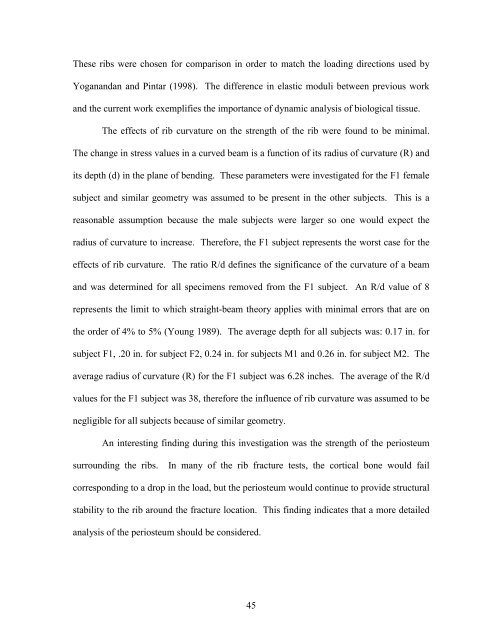Microstructural And Mechanical Properties Of Human Ribs Joseph
Microstructural And Mechanical Properties Of Human Ribs Joseph
Microstructural And Mechanical Properties Of Human Ribs Joseph
You also want an ePaper? Increase the reach of your titles
YUMPU automatically turns print PDFs into web optimized ePapers that Google loves.
These ribs were chosen for comparison in order to match the loading directions used by<br />
Yoganandan and Pintar (1998). The difference in elastic moduli between previous work<br />
and the current work exemplifies the importance of dynamic analysis of biological tissue.<br />
The effects of rib curvature on the strength of the rib were found to be minimal.<br />
The change in stress values in a curved beam is a function of its radius of curvature (R) and<br />
its depth (d) in the plane of bending. These parameters were investigated for the F1 female<br />
subject and similar geometry was assumed to be present in the other subjects. This is a<br />
reasonable assumption because the male subjects were larger so one would expect the<br />
radius of curvature to increase. Therefore, the F1 subject represents the worst case for the<br />
effects of rib curvature. The ratio R/d defines the significance of the curvature of a beam<br />
and was determined for all specimens removed from the F1 subject. An R/d value of 8<br />
represents the limit to which straight-beam theory applies with minimal errors that are on<br />
the order of 4% to 5% (Young 1989). The average depth for all subjects was: 0.17 in. for<br />
subject F1, .20 in. for subject F2, 0.24 in. for subjects M1 and 0.26 in. for subject M2. The<br />
average radius of curvature (R) for the F1 subject was 6.28 inches. The average of the R/d<br />
values for the F1 subject was 38, therefore the influence of rib curvature was assumed to be<br />
negligible for all subjects because of similar geometry.<br />
An interesting finding during this investigation was the strength of the periosteum<br />
surrounding the ribs. In many of the rib fracture tests, the cortical bone would fail<br />
corresponding to a drop in the load, but the periosteum would continue to provide structural<br />
stability to the rib around the fracture location. This finding indicates that a more detailed<br />
analysis of the periosteum should be considered.<br />
45



